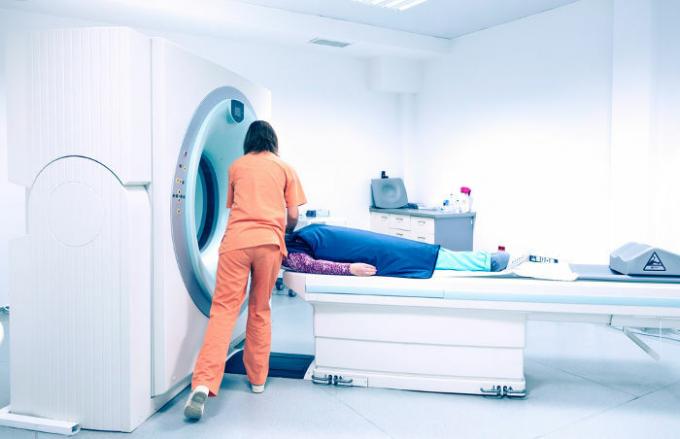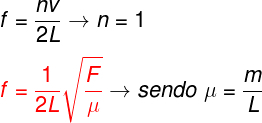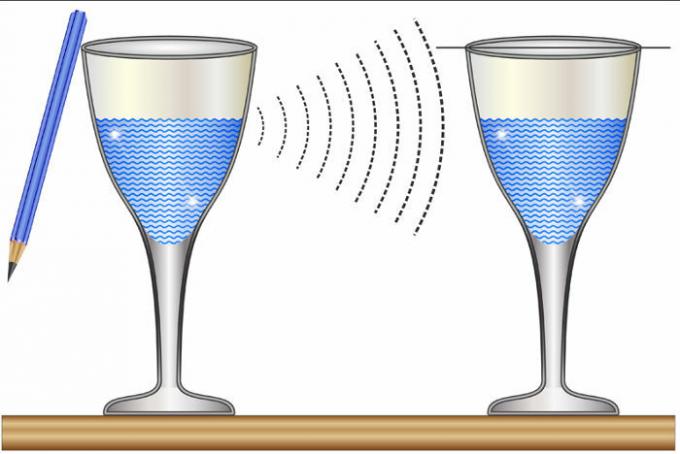Resonance is a physical phenomenon that occurs when a force is applied on a system with frequency equal to or very close to the fundamental frequency of that system. The resonance causes a increase in amplitude oscillation greater than that caused by other frequencies.
A simple example we can give is the resonance of mechanical systems. To put a balance at rest to oscillate, it is interesting that we apply a force on it periodically whenever it is at its highest point. By doing this, the system will switch to oscillateinamplitudeseachturnlarger. However, if the force is applied with a different frequency, we will not have the same efficiency in supplying energy to that balance.
Resonance types
There are several types of resonance: mechanics, sonorous,electric,magnetic, optical. Check out some examples:
Mechanical resonance: application of forces in an oscillatory balance, causing it to oscillate with increasing amplitudes.
Resonancesound: production of harmonics by musical instruments.
Resonance
electric: electrical circuits used in televisions, radios and cell phones use capacitors and inductors that can be tuned to resonate with the frequencies of radio waves. In this way, it is possible to capture and increase the amplitude of these waves, reproducing the information contained in them.Magnetic resonance: this type of resonance arises when a static, high-intensity magnetic field is applied to atomic nuclei. Then, an oscillating magnetic field causes the protons' magnetic fields to resonate, emitting radiation capable of producing sharp images of different types of tissue.
Resonanceoptics: it appears in reflective cavities and can be used to increase the light amplitude, producing high intensity light beams, such as the laser.
magnetic resonance
THE resonancemagnetic is a physical phenomenon of quantum origin that arises from a property present in protons and electrons called spin. O spin It is a species of magnetic field intrinsic present in several particles. When these particles are exposed to an intense external magnetic field, their spins line up in shape parallel or opposite to the external magnetic field, emitting in the process a small amount of energy, which can be detected by modern magnetic resonance devices. These tests can be used to provide details of the internal structure of organs and tissues that cannot be seen on tests such as a CT scan or x-ray.

Magnetic resonance arises from a quantum property of particles called spin.
Sound or acoustic resonance
THE resonancesonorous it happens when an emitting source manages to emit waves at frequencies very close to the natural oscillation frequency of a receiver. This natural frequency, also known as fundamental frequency, corresponds to the number of oscillations per second capable of producing harmonics, that is, wave frequencies capable of constructively interfering with themselves, producing a significant increase in their amplitude.
At gradesmusicals are examples of harmonics. Each musical note corresponds to a harmonic, and each harmonic is a multiple of the frequencyfundamental of the instrument. We call the fundamental frequency a smallerfrequency able to produce standing waves on a musical instrument.
Take for example the resonance in guitar strings: if we control the traction applied on the string, loosening or pulling its tuners, and its length, pressing it in one of its squares, we can select the harmonic that will be produced. The production of these harmonics happens when we put the string to oscillate. At that moment, two waves propagate along the rope in opposite directions. When reflected by the ends of the rope, these waves add upyouramplitudes (this phenomenon is called interference). This vibration is then transmitted to the air, producing the sound of musical notes.
THE frequencyfundamental of a guitar string can be calculated using the following mathematical expression:

f – harmonic frequency
no – harmonic number
L – length of rope
F – traction applied on the rope
μ – linear density of the string
m – rope mass
The frequencies produced by the guitar strings are determined by the densitylinear (μ) of the string, by the traction which is applied on it (F) and by its length (L).
See too: What is echo and reverb?
THE resonance sound also happens in instrumentsinblow. These instruments have a resonant cavity called pipesound. There are two types of sound tubes: open and closed. While closed sound tubes have one of their ends closed, open sound tubes have an opening on both sides.
In the sound tubes, the sound waves they reflect off the tube walls and resonate, producing harmonics. The calculation we use to determine the frequency emitted by a sound tube depends on whether that tube is open or closed. Watch:

f – harmonic frequency
v – speed of sound in the air
no – harmonic number
L – tube length
Lookalso: Learn to build your own wind instrument.
Using the equations shown above, we can easily determine which lengths of a closed sound tube produce harmonics. For that, it is necessary to use an experimental apparatus like the one in the following figure:

This apparatus consists of a water reservoir that communicates with the sound tube through a small hose. By changing the height of the reservoir, it is possible to control the length of the tube. Then just approach a tuning fork vibrating from this tube, changing the height of the reservoir until a clear increase in sound intensity is noticed. Thus, it will be possible to know which tube lengths result in resonance and, consequently, in the production of harmonics.
Lookalso: Know the differences between loudness, timbre and pitch.
Another well-known experiment is one that involves breaking a glass while singing certain musical notes. This is only possible when we sing exactly in the frequencyfundamental or in a multiple that frequency. If the sound stimulus is sustained long enough, the molecules in the cup will oscillate in ever greater amplitudes until the cup breaks.

For two identical cups to resonate, we just need to produce a vibration in one of them, which will be transmitted by air to the neighboring cup.
By Me. Rafael Helerbrock
